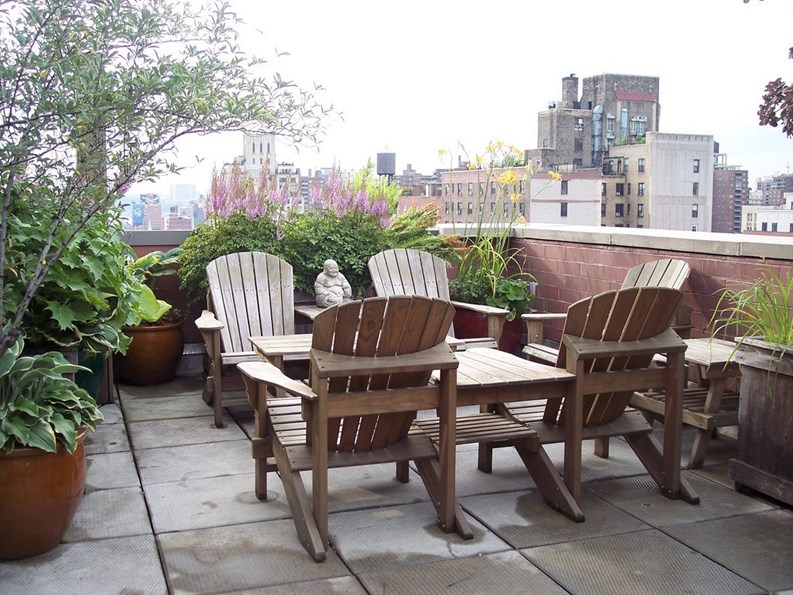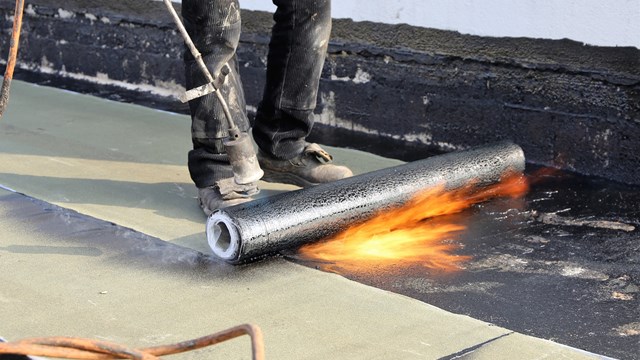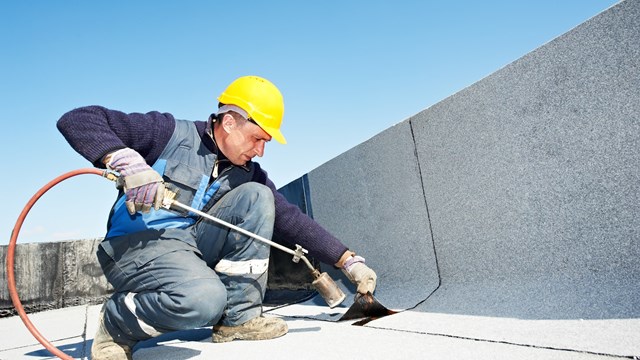The roof is the uppermost part of any residential building, serving as the first line of defense against whatever the skies throw at its inhabitants. In many New York co-op and condo buildings, the roof is also a social space, complete with decking, planters, awnings, and sometimes even sun chairs or a hot tub. These roofs do double duty—and as such, they're subjected to far more wear-and-tear than their restricted-access counterparts.
Let’s take a closer look at roof decks—how they’re made, and what they mean for your building.
Nuts and Bolts
Decks in New York City are typically made out of concrete or wood. What a building decides to use depends on their current site circumstances as well as budgetary allowances.
“Many condos and co-ops will go with concrete because it is durable and can easily meet any building and fire codes,” says Michael DiMezza, president of Outside Design Build, Inc. in Brooklyn. “It puts up with the sun and cold well and comes in wide array of colors and textures. There are even some newer products that are softer on the foot. When you compare it with wood, it has greater longevity and less maintenance.”
DiMezza says that despite the pros of concrete, many boards still choose to use wood as their primary decking material.
“Many clients go to wood and it is largely because of the aesthetics and the overall experience. Rooftops may just be a place for people to sit but often there are also gardens, trees and planters, using wood with that adds a more natural feel. It is beautiful and easy to work with, it is the gold standard of materials and it is much cooler than concrete,” he says.
Wiggins Lindor, sales director at Sitecraft Company in Long Island City, a division of The Rosenwach Group, adds that in terms of construction, wood is much lighter than concrete and it is more flexible in terms of design.
“With wood you also have a lot more options with how you want to install it versus concrete. You have more alternatives with wood, it is easy to carry and install. With concrete, you might not be able to install it on certain buildings because of the weight, especially older buildings, which may not be able to sustain the weight of concrete,” he says.
In addition to wood and concrete, many residential buildings are also using recycled plastic as a roof deck material. “The benefit of using the recycled plastic is that is it maintenance-free. You don't have to seal it or sand it. Once you put it down, it's lifetime-free maintenance, all you have to do is power wash it,” says Lindor.
Decks in the city are generally built on top of existing roof structures, so if one is to be installed, it is essential that the roof underneath be new—or at least in very good shape—before an actual deck is built. Otherwise, when the roof erodes, the deck will have to be taken down as well. The roof and the deck are two different things—two distinct layers on top of the building.
When a building board or HOA decides to install a roof deck, the board's chosen architect plans and executes the design, whether steel or concrete or a combination of the two, and sends it to the Department of Buildings (DOB) for approval.
The architect must consider the building’s structural allowance and the type of materials to use. “You don’t want the deck touching the roofing mechanism,” cautions Alan Daly, president of Greene Roofing in Brooklyn. “You want to have the roof accessible, so you can get under [the deck surface] to fix leaks and remove debris.”
Just as a building itself has to be constructed piece-by-piece, so a deck should be assembled in stages rather than prefabricated and simply put into place. “You want to have the deck made in sections,” says Daly. “You’re putting a deck on a tall building, so if there’s a leak, you want to be able to take it apart.”
The most important aspect of designing a rooftop deck in any setting, urban, suburban, or rural—and the most frequent cause of problems—is drainage. Rain and snow falls on structures hundreds of feet above the ground. Buildings are designed in such a way that the water runs away from the center of the roof toward the sides, and from there towards a system of internal drains that route the runoff to the ground and safely away from the building. Those drains need to be clean to function properly, so adding another layer of wood, concrete, or other material on top of them can make drainage tricky.
“The most overlooked maintenance issue in rooftop gardens and decks is drainage. Those drains should be cleared once a year so you don't see flooding, leaks, and do not have problems with owners who live below those installations. It is a simple thing to do. I've cleared 10-15 bags of soil from under decks, where maintenance hasn't been done in several years-- especially if you have planters or gardens. Just because those leaves fall in the crack doesn't mean that they disappear,” says DiMezza.
On those rare occasions when decks break down, when roofs leak or, worse, collapse, improper drainage tends to be the culprit. Drains get clogged, the water puddles up on top of the roof and then freezes, heavy snow falls on top of the layer of ice, and before you know it, there’s more weight on the roof than the structure can withstand. (This happened to a school in Queens one recent winter; leaves blocked the drains, water turned to ice, snow piled up, and boom—the roof fell in).
DiMezza also suggests power washing once a year to clear decks of debris and checking for trip hazards such as loose boards or protruding or cracked pieces of pavement.
“Maintenance is often the most overlooked aspect but is the most important part of your deck. Decks that are well-maintained well surpass the life span of those that are not maintained and it is not unusual for them to last ten or more years more,” he explains.
One more thing: you have to be safe. “Once you attach the deck, you need protection around the parapet wall so no one gets injured,” Daly warns.
Roof Decks Spell Value
The image of well-heeled New Yorkers enjoying the spectacular view on a roof deck overlooking, say, Central Park, is integral to any number of romantic comedies set in Manhattan. How many movies have a scene on a roof deck? What’s the point of living in a luxurious high rise building if you can’t access the tallest part of it?
A roof deck can make a big difference when putting an apartment on the market. Buyers love them. Realtors love them. “It’s great for resale,” says Wayne Bellet, owner of Bellet Construction in Manhattan. “You can’t argue that it's a beautiful amenity to have.”
But like many premium amenities—swimming pools, in-house gyms, and so forth—the allure of the roof deck might be greater than its utility. “It’s funny about roof decks. It’s been one of the most requested items, at least before the economy turned, because people find more resale value in it,” Bellet says. Co-ops and condos build them but some are underused..
Obviously, there are exceptions to this. The Fourth of July is a big one, when most of New York’s eight million inhabitants are suddenly compelled to take to their rooftops to view the light show. Although it may seem like a roof deck requires as little maintenance as an ordinary, undecked roof, this is not the case. There are hidden expenses associated with their upkeep. “There’s a lot to maintain,” says Bellet. “Not when it’s brand new—it’s a lot like a new car. It degrades over time, and money has to be spent. Plumbing, drains, security cameras, electronic access keypads, alarms, furniture, landscaping, lighting, electrical, and you need to up your insurance coverage—you name it. It’s like buying a dog—people often don’t realize how much comes along with it.”
Although roof decks are easier to maintain than, say, swimming pools, they still do require attention. Because they are on the top of the building, it can sometimes be a case of out-of-sight, out-of-mind. Exterior pros say that boards tend to be laissez-faire with respect to their decks until they find the need to regulate their use. “There won’t be any guidelines to use the deck until the board discovers something going awry,” Bellet says. It could be alcohol use, unwarranted activity or trespassing, loud parties, or issues involving young adults. Bellet says it’s wise for boards to develop guidelines with the help of an attorney so they will have explicit rules to follow.
He recommends implementing a simple rule: charge anyone who wants access to the roof deck a single dollar, in exchange for a key. If the resident winds up violating the rules, he or she must return the key—and get their dollar back. He also suggests financing maintenance by charging yearly dues for the right to use the deck. “Create the revenue from the people who use it.”
Bellet also worries about the future of roof decks in New York. The recent rise in catastrophic weather events—earthquakes, hurricanes, flash floods and snow storms; all of which have hit the city in the last year—can wreak havoc on roof decks. “Something that’s heavy to you and me, a solid wooden bench, becomes a life-threatening disaster when 75 mile per hour winds make it fly off a building.” And those little round tables with the frosted glass tops? “They can fly off the side of the building like Frisbees.”
The bottom line is that a well-maintained roof deck can be a welcoming and valuable amenity. For many New Yorkers one of the high points of city living is the urban vista they enjoy from their building's communal rooftop deck. Even when the view's not that great, just being able to enjoy the outdoors in a relatively private setting is a luxury certainly worth holding on to.
Greg Olear is a freelance writer and a frequent contributor to The Cooperator. Editorial Assistant Maggie Puniewska contributed to this article.







Leave a Comment